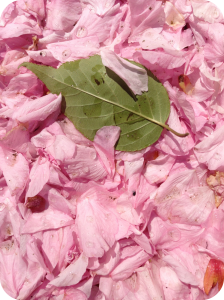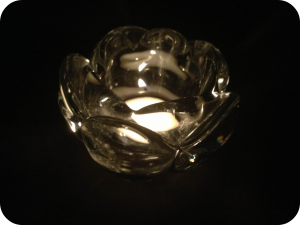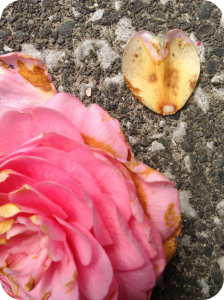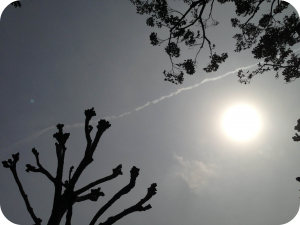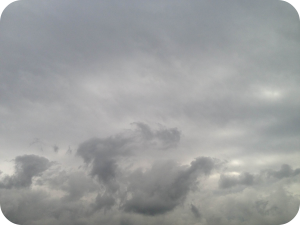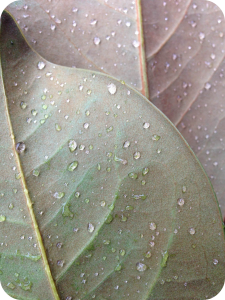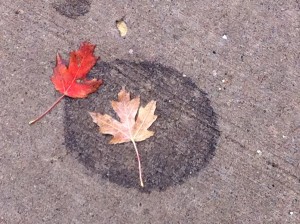Archive for the ‘Uncategorized’ Category
Eyes roaming in the half-darkness of the still room, I search for patterns in the ceiling spackle. My left arm aches under the weight of my 20-month-old, and I watch his cheeks move as he nurses in his sleep. Shifting slightly, I hold tight to my two-month-old, nursing on the other side, making sure she doesn’t slip down.
The thick heat of the afternoon presses in, overloading the air conditioner’s perseverant hum. I graze the sweat-soaked hair above my son’s ear with tender fingertips and stroke the other hand over my infant daughter’s leg.
We’d been out at the park all morning, my daughter strapped to my chest in her baby carrier, my son chasing baseballs and swinging his plastic bat through the densely humid air. Despite the tingling fatigue in my muscles, my mind is spry, eager to find some activity elsewhere.
Thinking about all I could be accomplishing while they sleep, I make mental preparations to physically extricate myself for the remainder of their nap. Gently, I attempt to ease my body away from my son’s pursed lips, but he immediately twitches, squealing and nuzzling for the breast again. Startled, my daughter kicks my abdomen and presses into the other breast with renewed interest.
Sighing, I settle into the mattress, closing my eyes. At once my mind is off again, galloping like a wild horse, trying to escape the room, the situation, the entire day. It takes up every thought that comes to it, turning each one over for examination. One particular thought it finds thoroughly fascinating, and it plays there for a long time, following an extended trail of hypothetical questions.
I’m entirely wrapped up in this inner wandering, unaware of how much time may have passed, when my son stirs again, whimpering and threatening to wake. Immediately my attention is there in my body, in whatever he needs. He’s dropped the breast from his mouth and he shifts, seeking it frantically, eyes still shut. I readjust, shifting so that he can nurse again, anxious for him to remain sleeping.
The restless beast of my mind kicks an impatient hoof, eager to be off again, but something keeps me fastened to this moment. The presence of my two sleeping babies fixes me here, to their sloped cheeks and their feathering eyelashes and their tiny bare toes and the soft up-and-down of their somnolent breathing.
Suddenly I’m keenly aware, as I often am these days, that moments like these won’t happen often. There will only be so many afternoons of the three of us piled together as one body. And though I know it’s perfectly okay—necessary even—not to pressure myself to be in love with every moment of mothering, something about this moment feels too rare and precious to be missed.
Just this moment where I’m utterly pinned to the fullness of my life. Just this moment where I’m pressed to these two bodies, to these two lives, which—at least for now—are wholly entwined with mine.
My eyes settle on the candle flickering at the center of the table, now littered with the nearly empty plates of our ten-person dinner party. I focus, watching the flame flutter and dance, then let my eyes blur until it’s nothing but a smear of light. Sharpening my vision again, I register the conversation rising and falling all around me, but make no attempt to engage. Having eaten and drunk as much as I have, I’m exhausted and overwhelmed by the effort of trying to concentrate on anything, much less a steady flow of words in a foreign language.
Nonetheless, the Danish words fill the room, lifting and dipping—near-meaningless sounds to me by this point, and nothing more. Seated near the center of the table, I’ve spent most of the meal shifting my attention between different conversations, depending on how much I could understand of each.
A lively one is going on to my left now, encompassing more than half of our group. Awareness of it crimps the edges of my consciousness, but concentration still eludes me. My attention is a helium balloon tethered to a rail, bobbing and swaying with each haphazard thought that passes through my mind.
A ripple of laughter momentarily interrupts their talking, and my host brother turns his face down toward mine, asking if I’ve understood. Shaking my head, I confess that I’ve been spacing out, that I’m far too tired to follow.
True to his self-appointed role as my most dedicated Danish teacher, he patiently explains what they’ve been talking about, bit by bit. My host mother joins in, her beautifully-phrased English pleasantly filling in some more information, and when they all pick up in Danish again I’m astonished to find that I’m suddenly part of it, understanding nearly everything.
My attention is fixed now, unwavering. They talk, passing the conversation between them like a ball, and I follow along with great curiosity. Several of the words they’ve just taught me act as keys to everything being said. Now that I have them, the syllables that were mere smudges of sound just a moment ago have become fascinating, bursting with significance.
A brief lull settles into the conversation and I choose that moment to speak, adding my own thoughts. The Danish words tumble out with ease, now seamlessly joined with the rest of my vocabulary. Six surprised faces turn toward me, and they urge me on, invite me in.
Where just moments ago I was drifting aimlessly, I’m now purposefully riding this wave, elated by my new comprehension and astonished at the difference it makes. Any residual fatigue is entirely gone; all I feel now is energy, the power of the words that are now part of what I’m able to do, part of who I am.
Hours later, my head finally on the pillow, I find the words are still active, still swimming—eager to perform again, to make meaning through me. Awash in gratitude, my mind at last lowers itself into sleep.
My brother and I float side by side in black inner tubes, he in the smaller one and I in the larger. Their peculiar, ancient rubbery smell mixes with the familiar scent of lake water warmed by a relentless summer sun.
Dragonflies hover and flit around us. Occasionally one stops to rest on a tube, its iridescent wings catching the late morning light. My tube’s the one that has our grandmother’s maiden name painted on it in crackly white letters. I run my finger along the raised surface of the O and wonder how old this tube is, how many generations have lazed here supported by its sturdiness.
“Let’s see who can stay up longer,” my brother says, hoisting himself up onto his tube. He wobbles, leaning to catch his balance until he finds his way to standing, one foot perched on each side of the tube’s slick black surface.
I smile, knowing I’m at an advantage, and pull myself up as well. We’re only a few feet apart, but as he shakes he drifts farther and farther away. I watch him waver, trying to retain his balance on the thinner rims of his tube.
I’m fully aware that on my much more buoyant and robust tube, I’m able to make waves that just might knock him over. Right now it appears that even a stray dragonfly drifting too close could tip him.
Starting slowly, looking him straight in the eyes, I sink my weight down and bounce a few times. Nervously, he tilts his gaze toward the water. Smirking, I watch his expression as the small waves rise up in concentric circles from under me and move in his direction. He trembles and, straining to keep his balance, leans back a bit too far. Instantaneously correcting himself, he tilts so far forward that before I know it he’s plunged under the water.
He comes up, hair wet and hanging like seaweed. Wiping his face with the back of his arm, he swims toward me with revenge in his eyes. Shrieking, I bounce faster, trying to move the tube away from him, but it’s no use. Before I can get very far he’s under my tube, spinning it so fast that I immediately fall backwards into the lake.
The translucent greenish-brown of the water surrounds me, cooling my sun-warmed body. I turn and kick down, down to where it gets even cooler, and rest there for a moment. Refracting rays of split sunlight blaze out under the surface of the water, catching tendrils of freshwater seaweed as they drift by. A sunfish swims past, busily shimmering green and gold.
I kick my legs again, up and up, breaking the surface of the water to gasp for sweet, humid air.
Wiping the water from my eyes, I find my brother lounging in the larger tube, looking as if he’s been sitting there all day.
He smiles slyly, splashing water in my direction with one foot. “Wanna try it again?”
Winter, 1989 / Eleven years old
We sit at the dining room table in companionable silence, my grandmother and I, cigarette smoke and a TV laugh track wafting in from the next room.
A box of old papers lays between us and I shuffle through them, occasionally finding one interesting enough to remove and read aloud. When I was small, she held me on her lap in her rocking chair, reading picture books and teaching me to sound out words. But ever since she lost most of her vision as a complication of diabetes, I’ve become the reader between us.
She’s childlike now, after her stroke last year, and while sometimes she sits in rapt attention as I read, other times she abruptly gets up and leaves, as if she can’t bear to stay still any longer.
Now she folds her hands in her lap and stares off into space with mostly unseeing eyes. Her face is open and peaceful, and I wonder what she’s thinking about.
Removing a tiny slip of brown-edged newspaper from the box, I scan down to find that it’s an obituary for someone with my grandmother’s exact name. I glance at her, curious, but she doesn’t look back at me.
“Hey, Gram?” I say. She turns toward me, her expression calm and pleasant. In this moment she really does look to me like a child, innocent and unreservedly loving. “Why’s there an obituary with your name on it in here?”
Before I even finish speaking, she drops her chin to her chest, face crumpling into despair. Confused, I look back at the paper and see that the birth and death dates are both in October, but only days apart. I look at her again, distraught by her anguish.
Standing, I take her face in my arms and press her to me, rocking her and laying my cheek against her cloud of soft white hair.
In a jolt of understanding I remember that one of my grandmother’s sisters had been named after their mother, and that another of her sisters had named a daughter after herself. Could this have been my grandmother’s baby? Why had no one ever told me?
Later, my mother will give me the story in its broadest outlines: her newborn sister left in the hospital for a simple surgery, the hospital volunteer who called my grandmother to brusquely report, “Your baby died. You need to come get her now.”
But right now I know none of that. Right now all I know is the pain of the beloved person in my arms, the undulating rhythm of her sobs, the soaking of her tears through my t-shirt.
Behind me the floor creaks, and I hear my mother’s sharp intake of breath.
“What happened?” she asks, moving toward us. Her voice, heavy with sympathy and love, is the one she uses when one of her children is hurt. It’s the voice that enfolds with its tenderness, the voice that aches to make it all better.
Summer, 1988 / Nine years old
Dipping my paddle into the dark water, I guide the canoe toward the widest part of the lake, just the way my grandfather has taught me. The night air reverberates with the steady hum of cricket song punctuated here and there by throaty bullfrog calls.
Despite the drought, humidity burdens the air with a heaviness that makes daytime scarcely bearable. But some nights a relative coolness ascends, as if the ground itself takes enough pity on us to offer up some small measure of its dank freshness.
Reaching the center of the lake, I stop and let my eyes sweep over my surroundings. The water’s edge is fringed so heavily with trees that the lights from the houses ringing the lake barely penetrate. Laying the paddle flat across the boat’s metal rim, my mind turns to my grandfather’s stories of anchoring his canoe out here and sleeping in it for the night. I consider lying down in the boat’s bottom, but remembering how dusty it is I instead tilt my head and lean back to observe more of the sky.
Taking in the full expanse overhead, my breath is at once shocked from my body. All the velvety space I’m accustomed to seeing in brighter suburban skies is now speckled, splashed, scattered with innumerable luminous pinpricks. I inhale deeply, letting the wet, earthy scents of the lake and its surroundings fill me up as my eyes consume this unfamiliar expanse of sky.
An image springs to mind of my dad before me, of his parents before him—of each of us having come out onto this little lake alone, each of us surely having had nearly this same experience. Who am I in relation to all of that, to the family name I carry? I say my full name to myself, repeating it over and over again, its sounds filling my head until it dissolves into mere syllables—empty, meaningless, ridiculous.
Suddenly it’s almost as if I’m suspended, my own identity a separate and scarcely recognizable thing. I’m a human animal sitting in a metal vessel, surrounded by water and the fathomless spread of a summer night sky. All of it matters and none of it matters. Unmoored, I float in this place of knowing and not-knowing. It seems my own name is not who I am. This is a wholly new idea, and utterly terrifying. If I’m not my name, my identity, then who am I? It’s as if I’m untethered, drifting solitary in an unknown world.
I pull my attention to the boat again, to the night breeze grazing my skin, to the smell of seaweed and the rustle of trees. Turning the canoe, I point its bow toward my grandparents’ dock, and within minutes I’m once again binding the rope to its friendly wooden sturdiness.
From up the slope, the warm lights of the house beckon me back to the familiar, to the familial, to all I already know
He walks toward me across the park, feet dragging and head bowed. Flopping into my lap, he folds himself in sideways and lays his ear against my heart.
“What’s wrong?” I ask.
He sighs heavily. “Nobody loves me.”
I’m glad he can’t see the surprise my face undoubtedly betrays, but he can surely feel it in the sudden rigidity of my body. This day was coming, I knew, but I didn’t think it would come before he’d even turned five.
I pause, resting my cheek on his head as I dig within myself for a response. “Is that really true?” I say after a moment.
He nods his head, certain.
“Let me ask you something,” I say, feeling around for the tools that have helped me and trying to formulate a way to share them with him. “Do you notice how when you think that thought, it’s sort of like a voice in your head saying something to you?”
He waits for a moment, maybe testing it out. “Yeah,” he says finally.
“And you see how you can notice that voice?” I ask.
“Yeah,” he says shakily.
“Well, that part of you that notices is the real you. The voice isn’t the real you. I know it feels like it is, but it’s not. It says things like that sometimes, because it gets confused and because it wants to protect you. But it doesn’t always know the truth.”
He thinks for a minute. “How do I know the truth, then?”
“You feel that part of you that notices? The part that hears the voice?” I ask. He nods. “That’s really you. Does that part of you feel that no one loves you?”
He pauses. “No,” he says after a moment. “You love me.”
“I really do,” I say. “And can you also feel that in your body?”
He takes a hand, still fleshed out with a slightly baby-ish chubbiness, and places it on his chest, fingers splayed wide. “Yeah,” he says. “Here.”
I smile and let my nose find his hair, inhaling its scent of sunshine and boy sweat. He sighs and settles into me more closely. “So, when you hear a thought from that voice and then you feel tight and sad, now you know that it’s not true. What do you think you could do at a time like that?”
“I don’t know,” he says.
“Maybe you could notice it, and ask yourself if it’s true?”
“Yeah,” he says. “And I could feel in my heart that it’s not true.”
“You could, yeah. It will probably say things like that again, and other things too. If you need help, you can always come to me and we’ll look at it together, okay?” I say, squeezing him tightly.
“Okay, yeah,” he says, his attention turning away from me now. He stands and wraps his little arms around my neck, swiftly kissing my forehead before he runs off to whatever’s next, feet kicking up tufts of dirt in his wake.
“So what’s new with you this week?” I ask the first of the four adult students squeezed into my cramped Tokyo classroom. His chair sits in the corner, squared in by a wedge of intense August sunlight. He mops his brow with a neatly folded handkerchief as he answers slowly, choosing each word with great care.
In turn, I ask each student some version of this question, stalling here and there to tease out the conversation and inwardly dancing with my own indecision. I could easily drop the plan for today’s lesson and just have a chat with them. Part of me leans toward that option out of the urge to avoid discomfort, but my curiosity gets the better of me and I ask them to pull out the packets I’d given them for homework the week before.
Before coming to class today they’ve read two newspaper articles—one chosen by me and one by a fellow student—and answered the corresponding comprehension questions I’d written out for them. They’re all advanced students, dedicated to learning English, and they’re here only because they enjoy it.
Still, like many Japanese students, they can sometimes become reserved to the point of total silence, fearful of saying anything incorrect or untoward. This is especially the case when the topic is controversial, and in the past when we’ve discussed politics or sexuality or Japan’s role in World War II, the room has filled with the kind of painful stillness that a conversation teacher tries to avoid at all costs.
Pairing them up, I direct their attention to the first article, the one I’ve chosen myself, and ask them to discuss it. They pause often to consult the article or my questions, keeping their eyes down, but for the most part their conversations move along at a relatively natural pace. Walking back and forth between them, I listen as unobtrusively as possible and make notes for feedback to give them later.
As we wrap up the first conversation, several of them turn to the next article—the one submitted by a student, and the source of my slightly nervous curiosity. My eyes find the headline upside-down on one student’s desk: Court allows transsexual to change her registered gender. I move them into new pairs and once again invite them into discussion, unsure of what to expect.
Standing back, I keep my eyes on my notes, not wanting to add to any discomfort they might be feeling. But within seconds their conversations start off engaged, animated, dynamic. I look up to see that they’re all leaning in toward one another, making full eye contact. They volunteer their own opinions and willingly, openly ask after those of their partners. Somewhat to my surprise, they all agree that this decision is right, that it treats Japan’s transsexuals with fairness.
Stepping back farther, I lean against the whiteboard, respect and admiration blossoming in my chest. I place my notes on my desk, forgetting them entirely, and just listen.
I peek into the dance studio, scanning the space before daring to enter. Pearl-gray morning light sifts through the two large windows on the opposite end of the room, reflected and expanded by the long wall of mirrors. Someone’s left one of the windows propped open, and a chilly breeze reaches all the way to the door where I stand, still hesitant.
Finally I get up the nerve to walk in and drop my things along the closest wall, with all the other bags and bottles of water. Despite the influx of fresh air there remains a certain pungency here, an atmosphere of movement, of effort, of striving.
People stretch, scattered throughout the space. One person props a balletic leg up against the back wall, another guides herself fluidly through yoga asanas. They all seem so comfortable in this room, so comfortable in their bodies. I sit and stretch too—for something to do, for a place to put my eyes.
The teacher catches our attention and briefly explains that the music will cycle through five rhythms: flowing, staccato, chaos, lyrical, and stillness. Provided we respect one another and the space, we’re free to move as we like, letting the music guide us.
Within seconds, my whole self stands up with a yes.
The music starts, and with it our bodies. I close my eyes and feel into it. The sounds are smooth, water-like. I let my arms drift upward and down again, leading with them. The rest of my body follows, responsive, unresisting, free of thought.
The first shift in music catches me by delightful surprise. Its rhythm is strong and assured; around me people move in sharp bursts, knees lifting, elbows jabbing, chins pointing. We each dance in our own world, and yet it’s clear in how we move through the space that these worlds are touching, unmistakably connected.
When it changes again, the music is carried on a drumbeat so solid that to follow is imperative. Every part of me gives way to a deep and thorough shaking. I have no desire to stop, but don’t think I could even if I wanted to. The beat transports me beyond cognition; there’s simply no room to resist.
The next piece is playful, buoyant. I meet the blue-gray eyes of another dancer and her smile sparks one of my own. Something joyous lifts in my midsection. Here there’s a freedom of movement, a lightheartedness in the wake of intensity.
The last rhythm is quiet, soothing. I lie on my back, drawing my knees to my chest and rolling gently. Looking around, I notice other dancers slowly undulating, and still others curling up within themselves.
Afterward, I smile to myself as I change into my street clothes, then notice that the girl with the blue-gray eyes is just to my left.
“First class today?” she asks.
“Yep,” I say, turning my face toward her.
“Never would’ve known,” she says, smiling in return and moving toward the door. “See ya next week.”
“Drawing’s not hard,” a friend once said to me as I enviously watched a detailed still life take shape under her hand. “You just have to look at what’s actually there instead of what you think is there.”
The truth of that statement slammed into me, hard. At the time—my early high school years—it was a concept I’d never considered. But suddenly it made sense why the figures I drew never really looked like people, why the trees never looked like trees. I was drawing the images I already held in my mind rather than what was actually in front of me.
It turns out that we do this all the time. Our minds fill in the blanks of the world around us, saving themselves time and energy as they do. This is highly adaptive, of course; having to pay full and deep attention to every detail of the world around us is exhausting and time-consuming. The ability of our brains to filter out what is already known—and thus deemed less important—frees up attention so we can focus on other things.
But it can also carry over into a state of dullness, of boredom. When we think we already know what’s there without even looking at it, the world can seem tiresome; every action we take can become tedious. Our natural human curiosity becomes buried under the sense of already knowing, and we lose the enjoyment of exploring our lives and our surroundings with care and interest.
If you hang out with young children, you can watch them investigate their own worlds with fathomless inquisitiveness. Things adults just walk on by without noticing become the source of deep and careful inquiry—not to mention joy. The delight children feel in the discoveries they make is a delight that’s still available to each and every one of us who’s willing to stop, to let go of the idea of what’s already known, and to really look.
Contemplative photography also opens a path toward this. Through the lens of the camera, what we see becomes the focus of our attention in a different way than it may have been had we just stopped to look. We begin to see shapes and lines, colors and textures in ways we hadn’t considered before, and in the moment or two when we’re snapping photos, our eyes and our minds are wholly focused on what’s actually there.
Because attention is the most sincere form of love we can give, what we pay attention to matters. It’s normal and natural that we’re sometimes bound up in thoughts that are unrelated to our surroundings—this is part of being human, of having a mind. But when we can remember to grant the fullness of our kind regard to what’s right there, new possibilities open to us.
What helps you stop and remember to see? How do you show love to the world around you through your attention? I’d love to hear your thoughts and ideas in the comments.
Through her online Seeing Drala course, Julie Einstein invites students to open up to the world around them and notice the beauty and magic that they might ordinarily overlook. Julie was kind enough to answer some questions about contemplative photography, otherwise known as miksang, her own practice, and her teaching.
What is contemplative photography and how does it differ from other ways of photographing the world around us?
Contemplative photography is appreciation of the moment a photograph is taken, the actual process of seeing, tuning into our perceptions and the magic or ‘drala’ that exists in our world. There is no post processing or editing of images. Process…not product…. Yes, there are quite often beautiful images to share with others but this is secondary to the actual moment we made a connection with the world.
How does using the camera as a tool for seeing help us to experience our perceptions differently?
I think that most of us need to use a camera as a reminder to start noticing the world around us. If our camera is with us then we will remember to use it! Obviously all of us are always looking and seeing as we go about our day but are we actually connecting, touching in, opening to the world or are we in our head thinking about what needs to be done, what we should have done, etc.
When we are thinking too much there is a lot that we don’t see. We are somewhat blinded to our surroundings. So the camera is used as a vehicle to help us remember to see. To capture a moment that stopped us – that flash of perception. After a while we don’t need to reach for our camera any longer as we are deeply satisfied with the connection we have made when we notice the magnificent maple tree shadow against the fence, or the bold red color of a woman’s hat or even the morning dew on a car door handle. The most simple and yet profound beauty that often goes unnoticed is now appreciated. This is ordinary magic.
When practicing taking photos in this way, what’s the relationship between the role of intention versus the role of thought?
Unless we are on a particular assignment (shooting color, light, etc) there really isn’t any intention other than slowing down enough to allow the world to present itself to us. It’s there all of the time … just waiting to be noticed. Once something stops us in our tracks, when we have that Flash of Perception, we do our best to form the equivalent of whatever it was that stopped us. We are trying to move away from thinking mind in contemplative photography because thinking gets tricky and thinking gets in the way of seeing clearly. Once we start to think about what to photograph and how we want to photograph we begin to move away from the purity of the moment. We might even begin to ‘add’ things to our photograph – something that we didn’t even see in the first place.
Part of the practice is learning to recognize when we are thinking too much and sometimes that means letting go and moving on. For the most part we don’t use the composition rules that are taught in most photography courses since our goal, if I dare use this word, isn’t to create the ‘perfect’ image. We simply want to share our perceptions with others.
When teaching about shooting images of texture, you make a distinction between our mental understanding of what texture is versus our being able to actually see the texture through the way light and shadow work in the image. For example, in an image of pavement that’s not well-lit, we might understand in our mind that there’s texture there but not be able to see all the bumps and hollows of the asphalt itself. Are there other ways our pre-conceptions or thoughts commonly assert themselves in this practice?
Great question!! Absolutely. We have so many ideas and concepts about the way things should be, the way photographs should look, how to make them look better, what will people like, what do I like, is it pretty or is it ugly, is it interesting or is it boring, is it worth photographing or not, I like the color red more than the color blue. The list goes on and on and on.
More importantly this mental dialogue takes place all the time and interferes with the way we perceive everything that takes place on a daily basis (not just what we see). She’s nice, he isn’t. The smell of coffee reminds me of that time I was in Paris. I hate frozen pizza because I ate it a lot as a kid. We see and experience the world through these filters but the absolute good news is that this can change. We have the ability to reframe how we see and how we experience our world which I find completely fascinating.
A good book to read on this is Letters to Vanessa by Jeremy Hayward. I highly recommend it to anyone who is interested in learning more about perception and how we perceive the world. He makes reference to an Enchanted World and a Dead World. The Enchanted World is the world in which we lived when we were children, clear and free of any filters. Exciting and enchanting. The Dead World is the world that we soak up unconsciously when we were growing up.
You quote John McQuade as saying, “Stop the mind by stopping the eye.” This sentence itself is quite arresting. Could you expand on it for us?
I like your use of the word ‘arresting’….Most of us are arrested by our mind. It’s what our mind does. It thinks. That’s its job. However, we can have moments of clarity. Moments of clear seeing. When we stop our eye, we stop our mind. The thinking stops. A gap occurs. This gap allows us the opportunity to experience something spectacular, something quite magical…we are making a connection, a heart connection with the world. It’s super fast but it’s super fantastic and it happens (or can happen) all the time as long as we are open to it.
What’s a Visual Haiku and what can we learn from them?
Haikus are Japanese poems that commonly reference a season; the tension between the changing seasons. There is usually a jolt of some kind, something that stops our mind. A visual haiku illustrates this tension through a photograph. Examples could be a leaf that has fallen into a puddle after a rain storm, a lost shoe emerging from the backyard after a long winter when the snow is melting, or dried out brown hydrangeas resting on the ground. Autumn is one of my personal favorite times to shoot. The landscape here in the Midwest is painted with golden yellow, red and brown leaves and so many different types of trees. It’s a feast for my eyes and for my soul.
A deep interest of mine is the interconnection between body, mind, spirit and emotions. Do you see contemplative photography as having a role to play in that connection?
Definitely with the mind. The photography practice itself is a nice start. This helps us to connect with the world. We learn how to sync our eye and our mind through assignments and exercises. However, we can go deeper. There are much more deeper teachings that can also allow us to connect with our heart; ultimately syncing eye, mind and heart. So on one level we can connect with our world and appreciate what we see but if we go deeper we have the opportunity to appreciate our lives in a way that maybe we didn’t before. Appreciation of our lives. Of our LIFE. This is powerful and this is possible. Is it spirit? Is it magic? Is it soul? Is it drala? I believe we are integrating all of these and probably much more. Regarding emotions? I can’t really speak for others but from my own personal experience I can say that when I feel connected and in touch, in tune, in communion with others, with nature, with the world, and with the lamp post I feel pretty darn good.
How has your teaching of contemplative photography affected your relationship with it?
Teaching contemplative photography is an honor. I am honored to share what I have been taught with others. I can’t not practice. It’s part of who I am. It’s how I experience the world now. However, teaching can sometimes raise questions about my own personal practice…am I practicing what I am teaching? I always do the assignments I give to students. This helps me to connect with them. It’s as though we are all seeing the same reflection in a water puddle or patch of light across a building. I feel in sync even though I might be on the other side of the world. That’s pretty awesome for me!
Anything else you’d like to add?
I am always amazed and inspired at the questions I get from students. These questions inspire me to learn more, to go deeper, to try harder. I especially love looking at the images that each student takes. Seeing the world through their eyes, seeing what their environment looks like. Seeing how their thinking mind sometimes gets in the way. Noticing how mine does the same thing too.
I think it is important to point out that these teachings are based on the Dharma Art teachings of the late meditation master and artist, Chogyam Trungpa Rinpoche who was the founder of Shambhala International.
Where can we find you online?
You can find me at www.julieeinstein.com.
Info on the class at www.julieeinstein.com/seeing-
Info on Nalanda Miksang International and www.miksang.org
